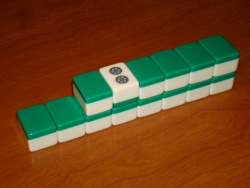Wanpai: Difference between revisions
| Line 17: | Line 17: | ||
|} | |} | ||
The kan draws are always the four tiles clockwise to the dora indicator. Not necessary but recommended, the first kan draw can be placed to the side of the second kan draw, like in the image to the right. This is to prevent accidental revealing of that first tile, in case it gets knocked off. | For every hand, the dead wall always starts with the very same arrangement. The [[kan]] draws are always the four tiles clockwise to the dora indicator. These are the '''rinshanpai''' {{kana|嶺上牌}}, which are only accessible via [[naki|calls]] for kan. Not necessary but recommended, the first kan draw can be placed to the side of the second kan draw, like in the image to the right. This is to prevent accidental revealing of that first tile, in case it gets knocked off. | ||
For every kan call, a player gains access to the dead wall and draws one rinshanpai. After a discard, one tile from the end of the regular wall is added to the dead wall to the back end. This is to retain the count of 14-tiles. Unlike the original dead wall tiles, the added tiles serve no function. If the rinshanpai produces a winning tile. then this draw invokes the yaku, [[rinshan kaihou]]. | |||
The | The remaining ten tiles from the dora indicator and counterclockwise are used for additional dora revealed by kan calls and in the event of a [[riichi]] winning hand. | ||
== Dora == | |||
{{main|Dora}} | {{main|Dora}} | ||
Revision as of 08:51, 12 January 2015
Wanpai 「王牌」 are the tiles used to form the dead wall. These tiles are set aside from the regular draw and discard play. Every mahjong hand session has 14 tiles, or 7 double-stacked tiles, set aside from the regular tile draw and discard processes. These tiles are considered to be out of play, hence the nomenclature "dead wall".
Arrangement

The fourteen tiles are arranged as follows:
| 1st kan draw | 3rd kan draw | Dora indicator | 1st kandora | 2nd kandora | 3rd kandora | 4th kandora |
| 2nd kan draw | 4th kan draw | 1st uradora | 2st uradora | 3rd uradora | 4th uradora | 5th uradora |
For every hand, the dead wall always starts with the very same arrangement. The kan draws are always the four tiles clockwise to the dora indicator. These are the rinshanpai 「嶺上牌」, which are only accessible via calls for kan. Not necessary but recommended, the first kan draw can be placed to the side of the second kan draw, like in the image to the right. This is to prevent accidental revealing of that first tile, in case it gets knocked off.
For every kan call, a player gains access to the dead wall and draws one rinshanpai. After a discard, one tile from the end of the regular wall is added to the dead wall to the back end. This is to retain the count of 14-tiles. Unlike the original dead wall tiles, the added tiles serve no function. If the rinshanpai produces a winning tile. then this draw invokes the yaku, rinshan kaihou.
The remaining ten tiles from the dora indicator and counterclockwise are used for additional dora revealed by kan calls and in the event of a riichi winning hand.
Dora
The dead wall is always responsible for indicating the dora. Among the dead wall, one tile is flipped and revealed for everyone. This tile is assigned as the dorahyouji 「ドラ表示」, or "dora indicator". It is always the third tile on the top row from the initial wall break. Tiles marked as dora are indicated as the next tile in the sequence, as noted in the "dora order".